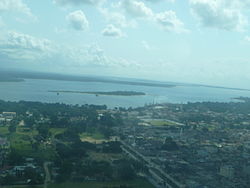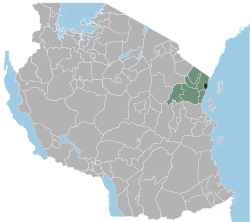Tanga, Tanzania
| Tanga | |
|---|---|
| City | |

Aerial view
|
|
 Location in Tanzania (dark green) |
|
| Country | Tanzania |
| Zone | Northern |
| Region | Tanga |
| Incorporated Town | 18911 |
| Incorporated City | 1 July 2005 |
| Government | |
| • Type | City Council |
| • Mayor | Omari Guledi |
| Area | |
| • Total | 536 km2 (207 sq mi) |
| Population (2012) | |
| • Total | 273,332 |
| • Density | 510/km2 (1,300/sq mi) |
| Time zone | EAT (UTC+3) |
| Postcode | 211xx |
| Area code(s) | 027 |
| Climate | Aw |
| Website | tanga |
| 1The Germans designated Tanga into a township after taking control of the coastal area from the Sultan of Zanzibar in April 1891 | |
Tanga is both the name of the most northerly seaport city of Tanzania, and the surrounding Tanga Region. It is the Regional Headquarters of the region. With a population of 273,332 in 2012, Tanga is one of the largest cities in the country. It is a quiet city compared to, for example, Arusha or Moshi with a comparable number of inhabitants.
The city of Tanga sits on the Indian Ocean, near the border with Kenya. Major exports from the port of Tanga include sisal, coffee, tea, and cotton. Tanga is also an important railroad terminus, connecting much of the northern Tanzanian interior with the sea. Via the Tanzania Railways Corporation's Link Line and Central Line, Tanga is linked to the African Great Lakes region and the Tanzanian economic capital of Dar es Salaam. The city is served by Tanga Airport.
The harbour and surrounding is the centre of life in Tanga. It is stretched out several km² into the country. It has several markets in several neighborhoods.
The earliest documentation about Tanga roots from the Portuguese. A trading post was established by the Portuguese as part of their East African coastal territory and controlled the region for over 200 years between 1500-1700. The Sultanate of Oman battled the Portuguese and gained control of the settlement by mid 1700 along with Mombasa, Pemba Island and Kilwa Kisiwani. The town continued to act as a Trading port for Ivory and Slaves under the sultan's rule. Tanga continued to be a prosperous trading hub for slaves with the Arab world up until 1873 when the European powers abolished the slave trade.
...
Wikipedia
